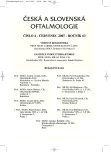Macular Edema after Cataract Surgery in Diabetic Patients without Retinopathy
Authors:
T. Jurečka; Z. Bátková; J. Ventruba; S. Synek
Authors‘ workplace:
Klinika nemocí očních a optometrie FN u sv. Anny
a LF Masarykovy univerzity, Brno
přednosta doc. MUDr. S. Synek, CSc.
Published in:
Čes. a slov. Oftal., 63, 2007, No. 4, p. 274-284
Overview
Purpose:
To study the effect of phacoemulsification on the development of macular edema and diabetic retinopathy in diabetic patients without preoperative retinopathy.
Patients and methods:
This study comprised 86 patients; 26 diabetics, who had no clinically detectable diabetic retinopathy preoperatively, formed a study group and 60 non-diabetics were included into the control group. Diabetes mellitus duration, preoperative hemoglobin A1c level, and diabetes treatment method were recorded in diabetics. Monocular cataract surgery was performed in all patients. The patients were clinically assessed with OCT examination preoperatively, and postoperatively on day 1, in week 1, and in months 1, 2, 3 and 6 respectively. Foveal, inner macular, outer macular thickness, and macular volume were analyzed.
Results:
The increase of the retinal thickness after the cataract surgery reached maximum in both groups in months 1 and 2. Since month 3 on, there was a progressive decrease in abnormal retinal thickness. There was a significant major increase in retinal thickness in diabetics in all examined areas in month 2 (p<0.05 for fovea and inner macula; p=0.001 for outer macula and p=0.005 for macular volume changes). Trend toward major increase in retinal thickness in diabetics was still evident even three months after the surgery. In no case did a diabetic eye develop clinically detectable diabetic retinopathy during the follow-up period. The correlation between hemoglobin A1c level and retinal thickness changes in diabetics was not significant. There was also no significant difference in final visual acuity between diabetics and non-diabetics.
Conclusion:
We can expect similar induced retinal thickness changes in diabetics without retinopathy as in non-diabetics after uneventful cataract surgery, though there was a trend toward major increase in retinal thickness in diabetics.
Key words:
cystoid macular edema, diabetes mellitus, optical coherent tomography, cataract surgery, phacoemulsification
Labels
OphthalmologyArticle was published in
Czech and Slovak Ophthalmology

2007 Issue 4
Most read in this issue
- Macular Edema after an Uncomplicated Cataract Surgery
- Clinical Results of the Aphakia Correction by Means of Secondary Implantation of the Iris-Fixated Anterior Chamber Intraocular Lens
- Analysis of Movement Disorders Surgeries at the Department of Ophthalmology, the FNKV Hospital, Prague, Czech Republic, during the Ten-Years Period
- Evaluation of Glaucoma Progression by Means of HRT II Results
